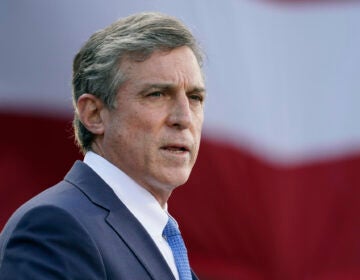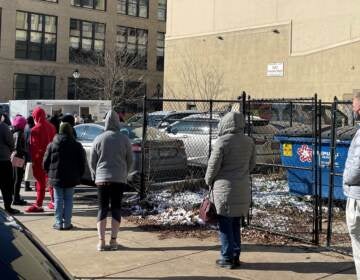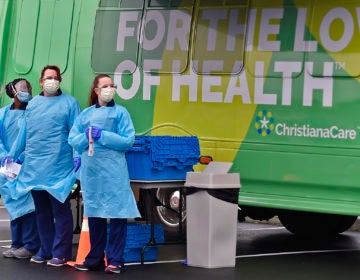Gov. Carney defends waiting until Delaware hospitals were ‘bursting at the seams’ to order masks indoors again
The governor acknowledged that hospital leaders had been urging restrictions, but said the business community is already pushing back.
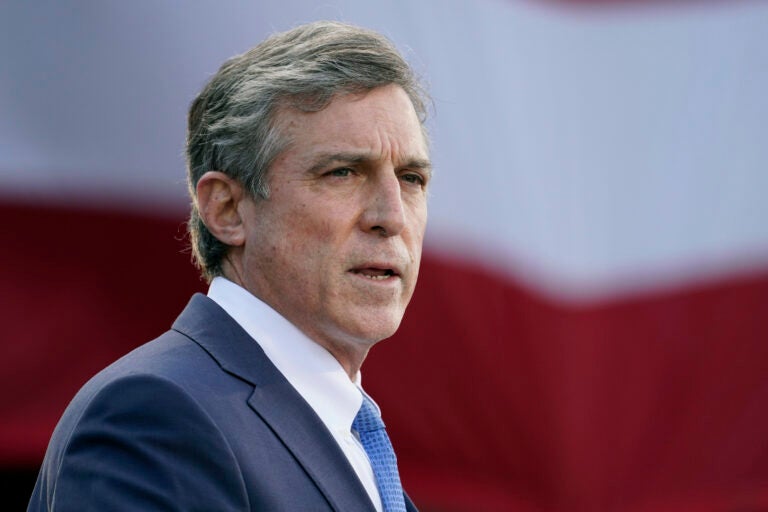
File photo: Delaware Gov. John Carney. (AP Photo/Evan Vucci)
Ask us about COVID-19: What questions do you have about the coronavirus and vaccines?
With a sweeping mask mandate once again in place in Delaware and most hospitals beyond capacity and in “crisis” care mode during the pandemic’s worst surge by far, Gov. John Carney is defending his decision to wait several weeks to reimpose restrictions.
The mask rule took effect Tuesday at 8 a.m., with the weekly average of daily infections at 2,753 — more than triple the previous peak a year ago.
There’s also 734 people in the hospital. That’s 260 more than the previous high a year ago and also includes a record 20 children getting care at Nemours Children’s Hospital near Wilmington.
Seventy-two patients are currently in critical condition, and 51 of those are on ventilators, state officials said. In the last two weeks, 50 patients with COVID-19 have died.
Carney said Tuesday that hospital leaders had been urging him to require masks even as he chose to push voluntary compliance during several public briefings. He acknowledged during a virtual briefing that with hospitals statewide “bursting at the seams,’’ he decided to act because it was obvious his pleas had not persuaded the public to wear masks to slow the rapid-fire spread through communities.
He finally issued the order at 2 p.m. Monday. It applies to workers and patrons of supermarkets, restaurants and bars, malls and other retail stores, hair salons, casinos and other public establishments. Houses of worship are exempted.
“We take one day at a time,’’ Carney said. “Hindsight is 20-20.”
The decision was a 180-degree shift for Carney. He has said for weeks, even as the highly contagious omicron strain began spreading through the country and state, that he did not want to put in more emergency rules, which he had finally lifted in July after 16 months. He had, however, continued to require masks in schools and government buildings, and on public transit.
Carney had explained during recent briefings that he didn’t want to harm businesses or tick off residents by limiting indoor gatherings or reinstituting a mask mandate for employees and customers.
Instead he kept pushing people to get vaccinated and if eligible, boosted. To date, 90% of Delaware adults have received at least one shot, but only 60% of residents age 12 to 34 have done so. For children ages 5 to 11, the rate is just 25%.
Yet on Monday, most hospitals statewide released a joint statement that said Delaware’s “health care system has been stretched beyond capacity.’’ So for the first time in history, ChristianaCare and several other healthcare systems decided that “normal standards of care” would be suspended and replaced with a “crisis of care” standard.
Only then did Carney act.
‘Didn’t want to leave any tool on the table’
Carney was asked Tuesday why he waited so long even though his health advisers and hospital leaders have been sounding the alarm during his recent briefings about the super-surge of cases and the burden on caregivers.
“Obviously, we know where we are now, but we could never predict where we would be,” Carney responded.
While it’s true that his advisers and hospital executives never predicted just how high the number of cases and those needing inpatient care would go, they weren’t hesitant in expressing their fears of a looming catastrophe.
Consider Carney’s briefing on Dec. 21, with daily cases already above the January 2021 peak. During the session ChristianaCare chief operating officer Sharon Kurfuerst bluntly stated that “the situation is dire” at Christiana and Wilmington hospitals, which were then up to 115% of inpatient capacity depending on the day.
“There are patients receiving care in hallways because that’s the only place we have to put them in the emergency department right now,’’ Kurfuerst said then. “Our staffing is stretched and we are juggling supply chain and equipment needs every day in order to ensure we are providing care to patients.”
Just four days before Christmas, Kurfuerst said “our ability to continue to provide care is without a doubt threatened as the volumes threaten to increase … This is a balancing act every single day.”
Carney reiterated Tuesday that he didn’t want to force masks on the public, but felt he had no choice.
“I always thought we could do the mask requirement in a voluntary way and said that several times over the last three or four weeks, with the expectation that private businesses would take that step too,’’ he said.
“They know their environments well to be able to make those decisions. It appeared that that wasn’t working both in the numbers and as I circulated in the community. With the hospitalization number reaching crisis proportions, [I] didn’t want to leave any tool on the table to try to stem the tide of new positive cases, but more importantly, any additional hospitalizations.”
Carney and Dr. Karyl Rattay, director of the state Division of Public Health, said they expect the numbers to keep rising for an indefinite time but eventually peak and then subside.
The governor said he’s already privately receiving “a fair amount of pushback” from the business community about the mask requirement, and hopes to remove it soon.
“I don’t want to have the mask mandate on one day longer than we have to, and we’ve had that conversation with those business establishments suffering the most during those conditions,’’ he said.
“I can tell you that our hospital partners would prefer us to have the mask mandate all the time prior to this and going forward. Obviously, we’re trying to strike the right balance there and it’s very difficult.”
One hospital system that has not moved to crisis care mode is Beebe Healthcare in Sussex County. But Dr. David Tam, Beebe’s chief executive, said Tuesday that “the situation is critical and can change at any moment.”
Tam added that “our staff is exhausted and continue to experience trauma. They are frustrated with the ongoing surge, staffing shortages across our state and country, and the perceived lack of realization of the enormity of the situation from those who are not working in healthcare.”

Saturdays just got more interesting.
WHYY is your source for fact-based, in-depth journalism and information. As a nonprofit organization, we rely on financial support from readers like you. Please give today.



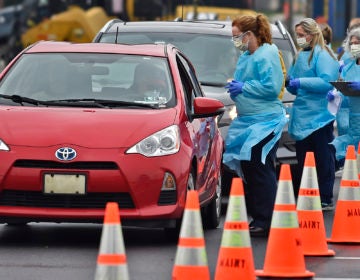

![CoronavirusPandemic_1024x512[1]](https://whyy.org/wp-content/uploads/2020/03/CoronavirusPandemic_1024x5121-300x150.jpg)
